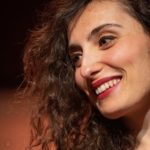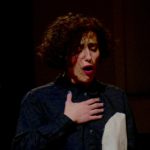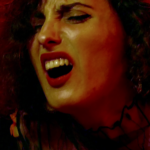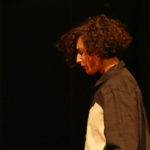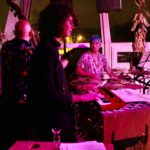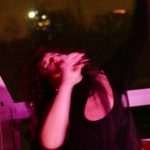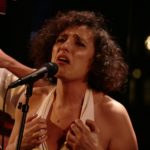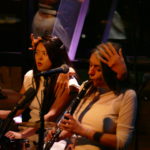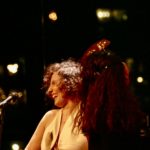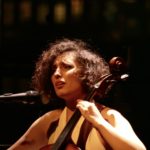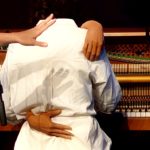- ©️Maarten Laupman
This is part 2 of the story of vocalist/cellist Sanem Kalfa. Part 1 you can read HERE
Sound-making: the real voice
“I always ask myself: is this the real Sanem speaking? There is so much music, there are so many thoughts, people, places and events happening around us. I think it’s important where you position yourself, where you stand in order to act in truest ‘being yourself’ mode while all these other things are happening around you. This way, it’s a question of a powerful balance between giving and receiving. Anything effortless and honest reaches me easily.”
To the comment that the voice is the foghorn of the soul, she replies:
“I believe that the voice is one of the channels of the soul through our body. Perhaps the most concrete one. You can call it the foghorn or anything else that speaks to your imagination.”
This opens up a fascinating conversation about different types of soul and about discovering your own kind of soul through shared musical travels and about her Dream Project entitled “Invisible Columns”. Music can lead to moments of intense contact with our own souls as well as with other souls’ vibrations and flames.
This means that while the inner light of our souls is burning, it is often obscured by a lot of internal and external noise and confusion (fog), such that we may even lose our way by losing the ability to feel or by avoiding certain internal areas. We can sigh or cry, cry or scream. We can yell or roar. But we are supported when we sing together. And we need our voice for laughing, too.
The physical voice and its qualities can lead us into and around in that fog. It can warn us of danger or pain. It can seduce us into following, immersing ourselves and even surrendering. It can soothe and open us up to mourning and acceptance. It can incite us to cross the threshold for doing cruel things. It is a central human organ and instrument when it comes to leading people.
“Indeed,” interjects Kalfa, “and it must be used wisely.”.
It can also allow us to experience the abyss, as well as dark, threatening shadows. It can conjure and heal. If we didn’t have this medium stimulating us to connect the internal to the external, we would be alone in a hell of inner noise or in a dead cave with muffled heartbeats discernible only at a distance.
Voice (“ses” in Turkish) and sound-making (“ses cikarmak” in Turkish) are an integral part of the movement of our bodies. As Kalfa says:
“I imagine it like this: emotions trigger the body, and the body reacts by producing sound.”
According to her, LISTENING in a broader sense is key for the emergence and shaping of music. Kalfa:
“Music comes from the depth of the ground to the limits of the sky – everything, everywhere. When we start filtering, then it becomes music.”
It means that children receive a multitude of sounds which have different effects on them and they are specifically attracted to human voices and their musical qualities when talking, humming and singing (as when Kalfa’s older sister sings Turkish lullabies for her as a primary voice). This plays a guiding role in the absorption of surrounding sounds. On the journey from sounds to music, the travelling continues from music back to sounds to create and enrich music. According to Kalfa, immersive listening with the whole body is also the basis for getting into the flow during performances. And then there are these moments of rising excitement when listening to music when performing yourself – but also when listening to and watching a performance.
There is the expression “music is in the air”, but neither air nor wind play music. It is we ourselves who hear it as music and can then build a wind harp, for example, to channel and shape this natural process. There is also the concept of musica universalis/music of the spheres (Johannes Kepler, 1571-1630) which perceives the movements and constellations of the universe in musical terms. A similar concept can be found in the biophonic work of electronic musician and biologist Bernie Krause (The Great Animal Orchestra (2012)). Remarkably, the latest theory of the universe, String Theory, is also based on vibrations. Kalfa feels very much connected to the idea that musicians are mediums who make it possible to hear music which, as she said “comes from the depth of the ground to the limits of the sky”. A medium is required to maintain a context-sensitive balance of noticing/receiving sounds and then shaping them in open, attractive ways.
The continuing creation process
Two examples of Kalfa’s continuing work of creation are Televisyon and a new, extended version of Miraculous Layers with a new line-up.
Televisyon is a new group formed by Kalfa around the core of the longstanding duo of Kalfa and pianist extraordinaire Marta Warelis by teaming up with Norwegian bedrock, bassist Ingebrigt Håker Flaten, and Amsterdam drummer Nasim López-Palacios Navarro, originally from the Canary Islands. The group comes up with music which is alive and kicking for the love of life inspired and informed by the shimmer of the tv and its backdrop of jumbled sound to extract dramatic television stories from it. The music is drawn from memories of times at home when the TV was on all day and all night, effectively becoming fluent wallpaper. You can stop watching, but you can’t escape its backdrop of jumbled sound which will insinuate itself into your memory. In this case, however, it’s not at all nightmarish, more of a joyful celebration involving jams which possibly evoke associations with hints of Blondie or even the Mothers of Invention. It was commissioned as an SITP production in Amsterdam.
The group Miraculous Layers will enter new, free waters with its line-up including saxophonist Tineke Postma. The group started working on extending its repertoire with a live performance-based strategy, developing music from the inherent musical features of the spoken word, a gradual process of crystallization (à la Steve Lacy) resulting in something between composition and improvisation. Kalfa’s cello-playing will take a bigger role, leading into a new counterpoint and coalescence of saxophone and cello.
- Sun-Mi Hong – Kamucan Yalçin
- Marta Warelis
- Marta Warelis
It is evident that Kalfa has a preference for duo work which will be further manifested in promising, thrilling combinations with guitarist Teis Semey, pianist Marta Warelis, pianist Harmen Fraanje and percussionist Sofia Borges (Whispers&Cries).
It will make room for Kalfa’s versatility, for the deepening her music and in future, for her free wingbeats which will eventually lead to as yet unknown multidisciplinary projects.
